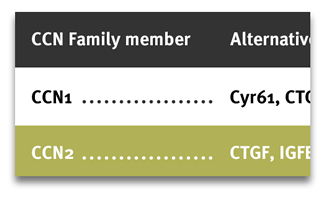
During several years the ICCNS was encouraging droping the use of misleading acronyms. In 2018, the CCN acronym has been officially assigned to Cellular Communication Networks factors by the Hugo nomenclature committee (5). We suggested that the official CCN nomenclature could also be used for other families of proteins involved in the regulation of signaling and communication (6). Brief history:
Two of the CCN proteins founders were encoded by immediate-early genes induced by the induction of cell proliferation, whereas NOVwas expressed only in quiescent cells and showed a tumor suppressor activity (7). Three WISP-induced proteins were later shown to share the unique tetra-modular organization of CCN proteins These proteins are involved in cell proliferation, apoptosis, invasion and metastasis in cancer cells.
Due to the multifunctional nature of these proteins, they have been identified in studies run by several different laboratories and they have been assigned multiple names that introduced confusion in their indexation and search performed in data bases such as PubMed.
Furthermore, some of these acronyms turned out to be misleading or too restrictive.
After this issue had been raised at the 2000 First International Workshop on the CCN Family of Genes, in Saint-Malo, a proposal was put forth to unify the nomenclature of the CCN family of proteins by The Steering Committee of the International CCN Society (B. Perbal, H. Yeger, L. Lau, C. Ayer, D. Brigstock, A. Perbal, G. Grotendorst, D. Pennica, P. Schofield).
The steering committee, proposed to designate the CCN genes and proteins in the order of their description in the literature. (J. Clin Pathol: Mol Pathol; 54: 108).
A proposal for a unified CCN nomenclature was published two years later by all the members of the steering committee (in alphabetical order) (8). Consequences of using misleading and inaccurate acronyms
The original acronyms were employed by several groups during many years, in spite of our efforts to point out the growing amount of scientific evidence against the maintenance of acronyms were misleading and/or inappropriate (6).
For different reasons relevant to human psychology, some groups kept using the old nomenclatures. For example, quite a significant number of data published under the NOV acronym were found to be very similar or identical to previous results published years before.
The situation turned out being very critical in the case of the CTGF acronym.
It has been established for many years that this molecule, and other CCN proteins are not genuine growth factors. Maintaining the use of this acronym was inaccurate and delivered untrustworthy conclusions on which new comers in the field might construct future projects.
Those who ignored voluntarily the increasing amount of data published on CCN2, and kept using the CTGF acronym to apply for grants and patents were fooling their potential readers and reviewers.
Those who keep refereeing to CTGF as a growth factor and ignoring the reciprocal regulatory mechanisms governing the expression of the CCN proteins in vivo, have a significant responsibility in regards to of the deleterious failures that have recently been publicly disclosed.
Conceptual and biomedical issues resulting from the use of misleading or too restrictive acronyms have been recently reviewed (9). References
1) P. Bork 1993 “The Modular Architecture of a New Family of Growth Regulators Related to Connective Tissue Growth Factor.” FEBS Letters 327:125-130];
2) O’Brien TP, Yang GP, Sanders L, Lau LF (1990) Expression of CYR61, a growth factor-inducible immediate-early gene. Mol Cell Biol 10(7): 3569–3577
3) Bradham DM, Igarashi A, Potter RL, Grotendorst GR (1991) Connective tissue growth factor: a cysteine-rich mitogen secreted by human vascular endothelial cells is related to the SRC-induced immediate early gene product CEF-10. J Cell Biol 114(6):1285–1294
4) Joliot V, Martinerie C, Dambrine G, Plassiart G, Brisac M, Crochet J, Perbal B (1992) Proviral rearrangements and overexpression of a new cellular gene (nov) in myeloblastosis-associated virus type 1- induced nephroblastomas. Mol Cell Biol 12(1):10–21
5) Perbal B, Tweedie S, Bruford E.2018 “The official unified nomenclature adopted by the HGNC calls for the use of the acronyms, CCN1-6, and discontinuation in the use of CYR61, CTGF, NOV and WISP 1-3 respectively.” J Cell Commun Signal.Dec;12(4):625-629.
6) Perbal, A., and B. Perbal. 2016. “The CCN Family of Proteins: A 25th Anniversary Picture.” Journal of Cell Communication and Signaling 10(3): 177–90.
7) Perbal, B. 2001. “NOV (Nephroblastoma Overexpressed) and the
CCN Family of Genes: Structural and Functional Issues.” Molecular
Pathology 54(2): 57–79.
8) Brigstock, D. R., R. Goldschmeding, K.‐I. Katsube, S. C.‐T. Lam, L. F. Lau, K. Lyons, C. Naus, B. Perbal, B. Riser, and M. Takigawa 2003. “Proposal for a Unified CCN Nomenclature.” Molecular Pathology
56(2): 127–8.
9) Perbal B. J Cell Commun Signal. 2024 “The case of Connective Tissue Growth Factor (CTGF) and the pit of misleading and improper nomenclatures.” Dec 19;19(1):e12062. doi: 10.1002/ccs3.12062. eCollection 2025 Mar. PMID: 39712858 Home